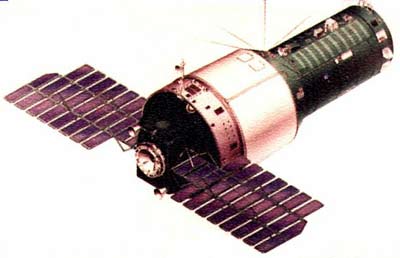Soviet Space Stations: Salyut 2 & Kosmos 557

Salyut 2 aka Almaz 1 or OPS-1 (source)
There isn't much information on Salyut 2; it was the first military space station, named Almaz 1 or OPS-1, but was publicly named Salyut 2 to disguise it as a civilian program. It launched in 1973, two years after the semi-successful Salyut 1, and one year after the failed launch of Salyut 2, and it was never visited by a human crew.
The Almaz Program
Chelomei had started work on the Almaz military space station in response to the American MOL years before the Salyut program even started, with several designs in the mid-60s. While many of the hulls were converted to a civilian configuration, some were actually used for their intended purpose, before it became apparent that automated spy satellites were much more cost-effective.

The two phases of Almaz designs before they were homogenized into the Salyut program (source)
The initial designs were very similar to the US Air Force's Manned Orbiting Laboratory, with a VA crew capsule mounted on the end and containing lots of reconnaissance equipment. Almaz was designed to be resupplied, where the MOL wasn't. To that end, Chelomei designed the TKS spacecraft, which was basically a VA crew capsule with an FGB service module. The TKS never flew for its intended purpose, and the VA never carried crew, but the FGB formed the foundation of Soviet space station modules for Mir and the ISS.
In the above picture, the 1970 Phase 1 design is most similar to what actually flew as Salyut 2, 3 and 5. However, the 1978 Phase 2 design is very similar to one configuration of Salyut 7.
Salyut 2 Design

Salyut 2 (source)
Salyut 2 followed the same general design as the main core compartments of Salyut 1, since Salyut 1 used Almaz hulls. The ends are quite a bit different, however; the narrower front end contained a hatch and orientation engines, and the wider aft end had a transfer compartment similar to that of Salyut 1, with a docking port, unique solar panels, an airlock, and two orbital engines. The scientific equipment onboard remains a mystery to this day, as it was highly classified because of its military purpose.
However, later Almaz stations carried Earth-pointing radars and even self-defense cannons, so it's possible that some form of these may have been present on Salyut 2.
The Mission
Salyut 2 launched on a Proton rocket in 1973, and successfully made it into orbit. Three days later, the discarded Proton third stage exploded, scattering debris in a wide cloud that struck the station 10 days after, depressurizing the hull and destroying the solar panels. Without a way to generate power, contact with the station was soon lost, and it drifted until orbital decay caused it to deorbit about a month later.
Kosmos 557/DOS-3 Postscript
To add insult to injury, the Soviet Union's third attempt to launch a civilian space station met a similar fate. DOS-3 was slated to be launched as Salyut 3, and successfully made it into orbit, but once out of range of Soviet ground stations, the flight control systems improperly activated and wasted all the fuel so it was unable to raise to a higher, more stable orbit, and it reentered 11 days later. Since it had already entered orbit and Western radars had spotted it, the Soviets couldn't hide its launch like they did the DOS-2 failure, so they named it Kosmos 557, a catchall designation for a variety of civilian and supersecret space projects throughout the Cold War.

DOS-3 in planned configuration, note the rearranged solar panels. The Soyuz visit never happened obviously (source)

Comments
Post a Comment